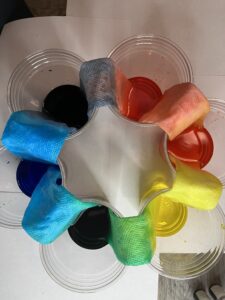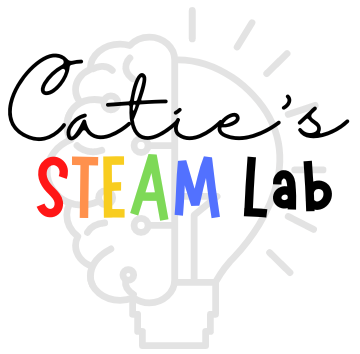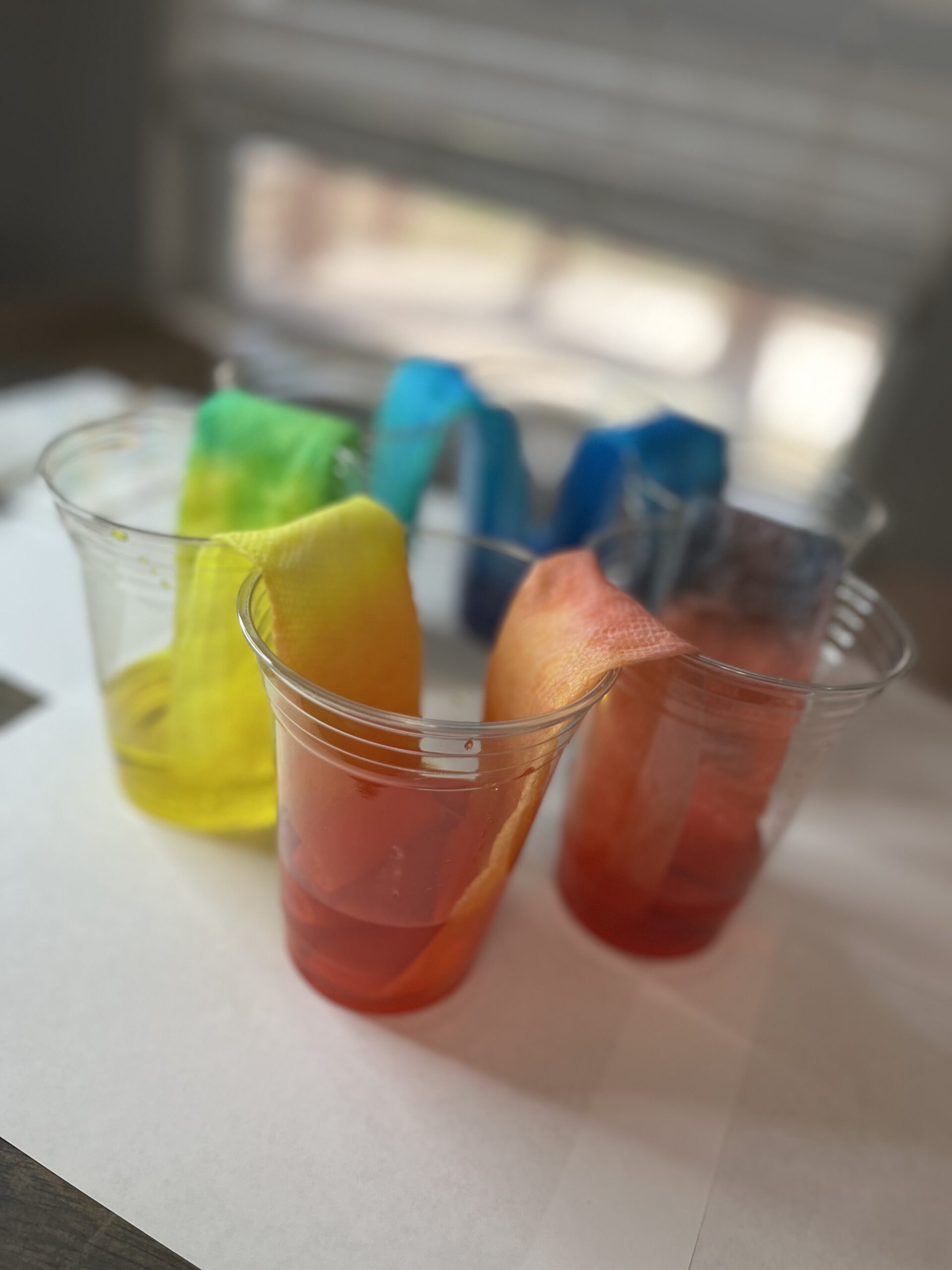As we head into spring, I love the introducing rainbows and color mixing to my classroom. Now my background is in Chemistry. I absolutely love the subject! I’m weird and I’m a nerd! That being said, I can’t exact teach a three-year-old chemistry. So when I come up with an idea that allows me to create opportunity to sneak chemistry vocabulary into the mix, you know I’m going to do! For this rainbow walking water experiment, I’m going to throw some vocabulary in, but I’ll get to those in just a minute.
This activity is so much for children! They will be amazed as red, yellow, and blue turn into orange, green, and purple! If I had a dime for every time I saw a child look up at me and say, “Ms. Catie, look! Blue and yellow make green”, I would be able to afford a ‘fancy coffee’ every morning! Now if you are looking for something that is quick and will fill a couple extra minutes, this may not be your experiment. However, if you are working with color theory and have a couple of minutes throughout the day to check on an experiment, THIS IS YOUR EXPERIMENT!
STEAM Integration
Science
I promised big fancy chemistry words and I intend on delivering! The first term that I would like to introduce is capillary action. Capillary action is responsible for the movement of water up small tubes, such as straws, or in this case a paper towel. There are attractive forces that cause the water to move up the paper towel or cause the water in a straw to be slightly higher than the water in the cup. That is the driving force that makes this experiment possible. Capillary action causes the water to climb up the paper towels, down into the cup, where the liquid from two different colors combines.
All things considered, it would be faster and easier to take a pipette and mix colors together. However, this experiment introduces capillary action to students, a lesson that can go more in-depth for older children and it will allow smaller children to see the mixture slowly. Watching the water creep up the paper towels will surely cause excitement in any children as they see something travel up and defy gravity!
Art
This activity is a fun on, especially if you are introducing color theory! Visually represent the color wheel and mixing colors very easily! The concepts of primary and secondary colors are easy to understand when start with your three primary colors, red, yellow, and blue, then create green, purple, and orange!
The cups will fill up with two primary colors and reveal which color is created by mixing those two colors. You will have your own “blue and yellow makes green” moments, I promise! One of the greatest parts of my job is watching children make independent discoveries during play. Seeing their discovery while mixing paints in my art center is a great feeling!
Making a Rainbow Walking Water Experiment
There are only a couple of things that you will need to gather for this experiment:
This post may contain affiliate links, which means I’ll receive a commission if you purchase through my links, at no extra cost to you. Please read full disclosure for more information.
- Clear plastic cups
- I used larger cups because that is what I had on hand. If you have smaller ones, or clear glass jars, those will work just as easily
- Food coloring
- Water
- White paper towels
- If you end up using smaller jars, consider using smaller pieces of paper towels. You still want the paper towels to be able to almost reach the bottom on both sides, but the more paper towel you have, the slower the process, as you will have more paper towel absorbing the water.
That’s it! Super simple and you can do it right from the comfort of your own home.
Next you have a couple simple steps to follow:
Step 1:
Fill three of your cups ¾ of the way full.
Step 2:
Add red food coloring to one cup. Add yellow food coloring to another cup. Add blue food coloring to the third cup. I was pretty generous with the amount of food coloring I added.
Step 3:
Arrange the cups into a circle. Alternate between a full cup and an empty cup. Each color should be separated by an empty cup.
Step 4:
Fold or cut your paper towels to size. Place one end of the paper towel strip into one of the three cups and add the other end an empty cup. Repeat this process for the other cups. Each cup should have two different paper towels in the cup. This is how the capillary action will fill the empty cups and cause the color mixing.
Step 5:
Wait. This process took a while to see the mixture process. It was so much fun to watch the color creep up in this rainbow walking water experiment.

Thank you so much for reading! I hope you have so much fun with this activity! How did it go for you? Let me know in the comments below!

